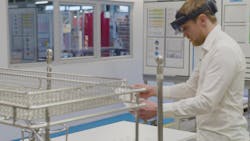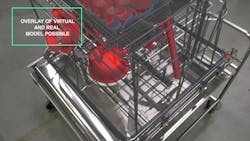The practical reality of augmented reality in processing
Augmented reality (AR) has quietly transitioned from a tech buzzword promising to revolutionize how workers interact with the manufacturing process into a practical, digital application offering to reduce errors in production, promote consistent product quality, support worker safety and streamline training, maintenance and operations.
AR refers to the computer-assisted addition of virtual elements to reality. AR integrates digital imagery, live-action animations, sound effects, voiceovers and other virtual elements into the real world to create a rich experience that enhances life in the real world. By contrast, virtual reality (VR) creates an entirely separate simulation removed from the real world. While VR draws splashy headlines and attention at the consumer level, AR is earning increased attention at the practical level in the pharmaceutical, chemical, and other process industries, where even seemingly minor errors must be prevented to avoid major consequences. While VR still requires the use of clunky, cumbersome headsets, AR software may be used while wearing enhanced glasses or by using a tablet or mobile phone.
Automation aftermath
Consider how automation and continuous processing have increasingly been used to minimize human involvement in the production process and decrease the risk of human error. Even prior to the COVID-19 lockdowns, most processors were automating as many steps in the production process as possible, primarily pursuing higher line speeds and lower costs given the relatively stable economic and labor conditions at the time. But the shock of the lockdowns and COVID-driven pandemonium triggered a spike in demand for automated machinery as managers frantically tried to compensate for the loss of staff and the inability to depend on staff to arrive at the plant each day.
Reliable, unattended, 24/7 machine operation and low maintenance needs often replaced higher line speeds and lower costs as the primary goals. Batch processing began to cede share to continuous processing as companies examined every step in the process, from sourcing and receiving raw materials to delivering finished products, for potential automation opportunities. With cleaning, sanitation and worker safety joining the top priorities amid unprecedented workforce turmoil, automation garnered substantial investments at companies large and small.
Yet, after major tasks such as bulk material transfer, dosing, mixing, encapsulation, tablet compaction, filling, packaging, and material handling have been automated, a number of manual tasks remain that are impractical to automate but must be performed correctly every time to meet quality and regulatory requirements. Unloading and transferring raw materials from storage without introducing contamination; monitoring, inspecting and documenting product quality; setting up and operating machinery; and loading wash racks for cleaning and sterilization are among the vital yet mundane tasks that still threaten otherwise state-of-the-art processes with human error. In validated, cGMP processes, minor errors and oversights may invite costly enforcement action, delay production and negatively affect product quality.
For example, a pharmaceutical manufacturer may invest handsomely in an automated cleaning and disinfection system with a wash rack that is custom designed to safely hold a predetermined set of items ranging from glassware for laboratories to transport containers, carts, cages, bottles and equipment for use in cleanrooms. The wash rack holds each item in its own place to ensure complete cleaning and decontamination and prevent movement or damage during the washing, rinsing and drying processes. However, a worker lacking in training, experience or focus may mistakenly load items in the wrong place, insert the rack into the washing system and run a complete cycle, resulting in broken components and cracked or shattered glass. Or worse, components may be intact and appear clean when, in fact, they are still contaminated.
An AR training application can show the operator a full-color, 3D, digital model of the fully loaded wash rack as custom-designed side by side with the actual wash rack to be loaded in real life. Audible guidance and visual cues ensure that the operator sets each beaker, barrel, funnel, jug, hose, fitting, bottle or other item in its proper place. The application can use nearly any vocal style and language based on the specific needs of the facility, department or even individual employee. As a supplemental training tool, this type of AR application offers non-stop, visual access to standard operating procedures, operating manuals and other technical data with verbal coaching exactly at the time when the required knowledge is most practical and vital.
Similarly, the machinery for production, filling, packaging or other processes requires workers to set up the parameters correctly. A seemingly minor error at the touch-screen HMI can waste an entire batch or lot and cause costly line downtime, missed production deadlines and other cascading effects. Yet, the lack of skilled, experienced workers only adds to the risk of human error. AR offers visual instruction for machine operation side by side with the actual control panel or as an overlay with expert guidance, as if a veteran technician were walking the trainee through the process. Other tasks that are critical to the operation and to meeting stringent regulatory compliance requirements, such as refilling the detergent in a cleaning system, replacing filter elements in a steam sterilizer system or performing a Bowie-Dick test can also be supported with AR.
Augmenting maintenance
The retirement of veteran technicians and the challenge of attracting and retaining the next generation of skilled workers is making it challenging for processors to keep their equipment operating as originally specified. In many cases, processors are either operating with outdated or inefficient equipment or relying on costly outside services for maintenance. In other cases, entry-level workers are being tasked with managing new, automated equipment and, in the event of unplanned downtime, the entire operation may be crippled.
Using AR, a worker can correctly perform common preventative maintenance checks with confidence. For example, to check steam sterilizer particle filters for accumulated material and assess the need for cleaning or replacement, AR offers an additional layer of insight to safeguard against a mistake. This enhanced visual tool may highlight the filter components, label each one and provide a side-by-side comparison of a filter that needs to be replaced and a filter that may remain in service to make the decision easy for nearly anyone on staff. Then, if the filter needs to be replaced, the tool can present the proper steps for replacement.
In the event of unplanned machine downtime requiring an immediate diagnosis and repair assessment, AR can help in-house staff return the line to service without the costly delay of waiting for an outside technician to arrive or without an outside service call entirely. Interacting within an immersive, animated view of an entire machine, the in-house worker may compare the real-life machine or system to the augmented, labeled view to find a difference or failure and then walk through the repair process step by step.
Further, AR can demonstrate how to safely test and/or replace a part or assembly to get the line up and running before an outside vendor can dispatch a service technician. Checking and/or replacing sterilizer door seals or assessing the remaining life of a drive belt in a tablet counter, among myriad other examples, may be flawlessly and safely performed by less experienced workers armed with the support of AR showing exactly how to perform the inspection and replacement processes.
Given the vast range of manual tasks involved in the process industries and the potentially deadly cost of human error, AR offers vital, practical support for training, maintenance and efficient operation at a time when labor issues raise serious concerns for managers responsible for meeting challenging quality standards and providing a safe work environment.
Jochen Schlag is director of marketing, sustainability and product manager in Pharmaceutical Systems Engineering for Belimed Life Science. The company designs, manufactures and services steam sterilization and automated wash systems and develops custom augmented reality training aids to help prevent human error. For more information, call 585-329-0497 or [email protected].
Belimed Life Science
About the Author
Jochen Schlag
Director of marketing, sustainability and product manager in Pharmaceutical Systems Engineering for Belimed Life Science
Jochen Schlag is director of marketing, sustainability and product manager in Pharmaceutical Systems Engineering for Belimed Life Science. The company designs, manufactures and services steam sterilization and automated wash systems and develops custom augmented reality training aids to help prevent human error. For more information, call 585-329-0497 or [email protected].


